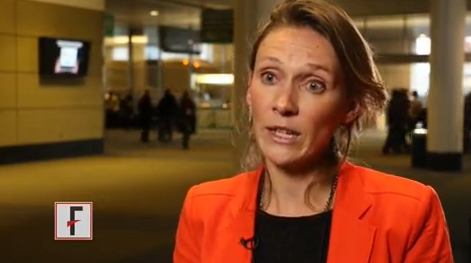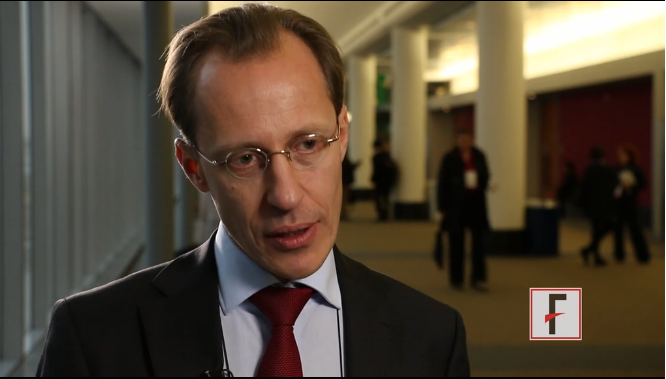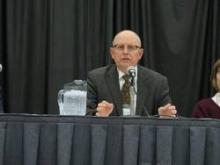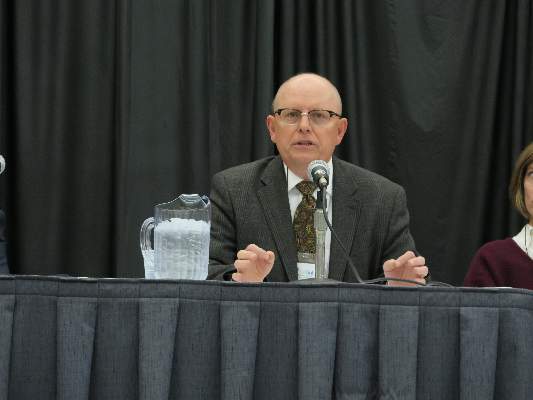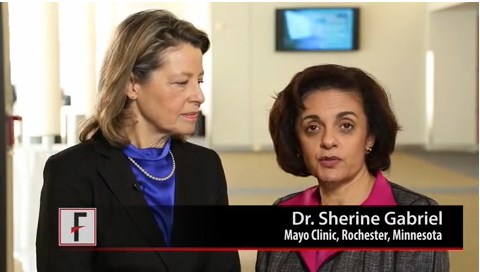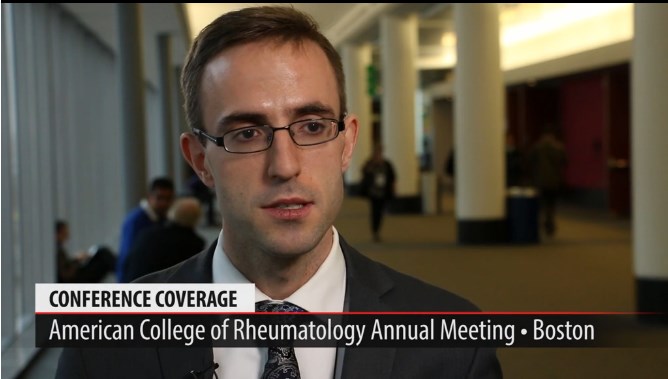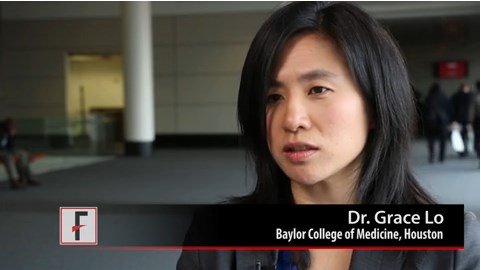User login
American College of Rheumatology (ACR): Annual Scientific Meeting
VIDEO: BeST seeks to define best initial therapies for JIA
BOSTON – What is the best initial therapeutic approach to RF-negative polyarticular, oligoarticular, or psoriatic juvenile idiopathic arthritis (JIA)?
The BeST for Kids study is a multicenter, 2-year, randomized trial that is examining the utility of three different treatment arms in disease modifying antirheumatic disease-naive children, aged 2-16 years, with JIA durations of less than 18 months. The study also examines whether inactive disease is a realistic treatment target, if drug-free remissions are possible, and whether restarting medication is effective when relapse occurs.
In our exclusive interview at the annual meeting of the American College of Rheumatology, Dr. Petra C.E. Hissink Muller of Leiden University Medical Center in the Netherlands, discusses the trial’s rationale and initial results from the first 3 months of the study.
The video associated with this article is no longer available on this site. Please view all of our videos on the MDedge YouTube channel
BOSTON – What is the best initial therapeutic approach to RF-negative polyarticular, oligoarticular, or psoriatic juvenile idiopathic arthritis (JIA)?
The BeST for Kids study is a multicenter, 2-year, randomized trial that is examining the utility of three different treatment arms in disease modifying antirheumatic disease-naive children, aged 2-16 years, with JIA durations of less than 18 months. The study also examines whether inactive disease is a realistic treatment target, if drug-free remissions are possible, and whether restarting medication is effective when relapse occurs.
In our exclusive interview at the annual meeting of the American College of Rheumatology, Dr. Petra C.E. Hissink Muller of Leiden University Medical Center in the Netherlands, discusses the trial’s rationale and initial results from the first 3 months of the study.
The video associated with this article is no longer available on this site. Please view all of our videos on the MDedge YouTube channel
BOSTON – What is the best initial therapeutic approach to RF-negative polyarticular, oligoarticular, or psoriatic juvenile idiopathic arthritis (JIA)?
The BeST for Kids study is a multicenter, 2-year, randomized trial that is examining the utility of three different treatment arms in disease modifying antirheumatic disease-naive children, aged 2-16 years, with JIA durations of less than 18 months. The study also examines whether inactive disease is a realistic treatment target, if drug-free remissions are possible, and whether restarting medication is effective when relapse occurs.
In our exclusive interview at the annual meeting of the American College of Rheumatology, Dr. Petra C.E. Hissink Muller of Leiden University Medical Center in the Netherlands, discusses the trial’s rationale and initial results from the first 3 months of the study.
The video associated with this article is no longer available on this site. Please view all of our videos on the MDedge YouTube channel
AT ACR 2014
Experimental antibodies target cytokines to calm SLE
BOSTON – Two investigational monoclonal antibodies, each targeting a different cytokine, showed good activity against systemic lupus erythematosus in two separate studies presented at the annual meeting of the American College of Rheumatology.
Sifalimumab, a fully human monoclonal antibody that binds to and neutralizes several different subtypes of interferon-alpha (IFN-alpha), was better than placebo at improving measures of systemic lupus erythematosus (SLE) disease activity in 431 patients enrolled in a phase IIb safety and efficacy study, said Dr. Munther Khamashta of the Graham Hughes Lupus Research Laboratory at King’s College London.
“The primary endpoint, SRI [Systemic Lupus Erythematosus Responder Index] response at 52 weeks, was significant at all doses of sifalimumab, compared with placebo,” he said at the meeting.
There were no major unexpected adverse events with the drug. Investigators have previously documented increased frequency of herpes zoster infections in patients receiving sifalimumab, but the infections respond promptly to antiviral medication, he added.
Sifalimumab is targeted against the type I interferon receptor present on most cells. The specific target is IFN-alpha, the predominant subtype of type I interferons, which have been shown to play a key role in the pathogenesis of SLE.
In the phase II study, 431 adults with moderate to severe active SLE were screened and randomly assigned to receive either sifalimumab in an intravenous infusion every 4 weeks for 1 year at one of three doses – 200 mg, 600 mg, or 1,200 mg – or to placebo on the same schedule. The patients were permitted to receive up to three oral or intramuscular burst and taper steroids up to day 127 of the study.
SRI responses at 52 weeks were seen in 45.4% of patients on placebo, 58.3% of patients on the 200-mg dose (P vs. placebo = .057), 56.5% on the 600-mg dose (P = .094), and 59.8% for the 1,200-mg dose (P = .031).
Dr. Khamashta said that, at the final analysis, the investigators considered a P value less than .098 to be statistically significant because they needed to adjust for a type 1 error rate of 0.1 in the primary endpoint after they performed an interim analysis of the data.
There also were significant improvements in the sifalimumab arms vs. placebo in affected joint counts and in two secondary endpoints at specific doses: improvement in skin rash as measured by CLASI (Cutaneous Lupus Erythematosus Disease Area and Severity Index) and improvement in fatigue.
Anti–interleukin-6 monoclonal antibody tested
An investigational monoclonal antibody targeting a different cytokine, interleukin-6 (IL-6), appeared to reduce the severity of lupus flares, with activity occurring as early as 24 weeks, in a phase II, dose-ranging study of 183 patients with active SLE, said Dr. Daniel J. Wallace, a rheumatologist at Cedars-Sinai Medical Center in Los Angeles.
Although the drug was deemed to be safe at doses of 10 mg and 50 mg given by subcutaneous injection every 8 weeks, there were four deaths attributed to the medication, including two cases of pulmonary embolism and one of cardiorespiratory arrest in patients treated with the 200-mg dose and a suspected pulmonary embolism in a 32-year-old woman treated with the 10-mg dose. The investigators said that Pfizer, the study sponsor, determined that further studies are warranted to better characterize the benefits and risks of the 10-mg and 50-mg doses but will no longer study the 200-mg dose.
The biologic drug, still known only as PF-04236921, is a fully human antibody that binds to and neutralizes the IL-6 ligand rather than the receptor.
Dr. Wallace said that the rationale for targeting IL-6 in lupus is that there are increased IL-6 levels in the disease produced by T and B cells. Hyperactive B cells from SLE patients produce large amounts of immunoglobulins, and blocking IL-6 decreases immunoglobulin and anti-DNA production. A small, open-label study conducted at the National Institutes of Health with an anti-IL-6 receptor showed promising clinical and serologic responses, he noted.
The study reported by Dr. Khamashta was supported by AstraZeneca. He disclosed research grants from Bayer. The study reported by Dr. Wallace was supported by Pfizer. He reported having no relevant disclosures.
BOSTON – Two investigational monoclonal antibodies, each targeting a different cytokine, showed good activity against systemic lupus erythematosus in two separate studies presented at the annual meeting of the American College of Rheumatology.
Sifalimumab, a fully human monoclonal antibody that binds to and neutralizes several different subtypes of interferon-alpha (IFN-alpha), was better than placebo at improving measures of systemic lupus erythematosus (SLE) disease activity in 431 patients enrolled in a phase IIb safety and efficacy study, said Dr. Munther Khamashta of the Graham Hughes Lupus Research Laboratory at King’s College London.
“The primary endpoint, SRI [Systemic Lupus Erythematosus Responder Index] response at 52 weeks, was significant at all doses of sifalimumab, compared with placebo,” he said at the meeting.
There were no major unexpected adverse events with the drug. Investigators have previously documented increased frequency of herpes zoster infections in patients receiving sifalimumab, but the infections respond promptly to antiviral medication, he added.
Sifalimumab is targeted against the type I interferon receptor present on most cells. The specific target is IFN-alpha, the predominant subtype of type I interferons, which have been shown to play a key role in the pathogenesis of SLE.
In the phase II study, 431 adults with moderate to severe active SLE were screened and randomly assigned to receive either sifalimumab in an intravenous infusion every 4 weeks for 1 year at one of three doses – 200 mg, 600 mg, or 1,200 mg – or to placebo on the same schedule. The patients were permitted to receive up to three oral or intramuscular burst and taper steroids up to day 127 of the study.
SRI responses at 52 weeks were seen in 45.4% of patients on placebo, 58.3% of patients on the 200-mg dose (P vs. placebo = .057), 56.5% on the 600-mg dose (P = .094), and 59.8% for the 1,200-mg dose (P = .031).
Dr. Khamashta said that, at the final analysis, the investigators considered a P value less than .098 to be statistically significant because they needed to adjust for a type 1 error rate of 0.1 in the primary endpoint after they performed an interim analysis of the data.
There also were significant improvements in the sifalimumab arms vs. placebo in affected joint counts and in two secondary endpoints at specific doses: improvement in skin rash as measured by CLASI (Cutaneous Lupus Erythematosus Disease Area and Severity Index) and improvement in fatigue.
Anti–interleukin-6 monoclonal antibody tested
An investigational monoclonal antibody targeting a different cytokine, interleukin-6 (IL-6), appeared to reduce the severity of lupus flares, with activity occurring as early as 24 weeks, in a phase II, dose-ranging study of 183 patients with active SLE, said Dr. Daniel J. Wallace, a rheumatologist at Cedars-Sinai Medical Center in Los Angeles.
Although the drug was deemed to be safe at doses of 10 mg and 50 mg given by subcutaneous injection every 8 weeks, there were four deaths attributed to the medication, including two cases of pulmonary embolism and one of cardiorespiratory arrest in patients treated with the 200-mg dose and a suspected pulmonary embolism in a 32-year-old woman treated with the 10-mg dose. The investigators said that Pfizer, the study sponsor, determined that further studies are warranted to better characterize the benefits and risks of the 10-mg and 50-mg doses but will no longer study the 200-mg dose.
The biologic drug, still known only as PF-04236921, is a fully human antibody that binds to and neutralizes the IL-6 ligand rather than the receptor.
Dr. Wallace said that the rationale for targeting IL-6 in lupus is that there are increased IL-6 levels in the disease produced by T and B cells. Hyperactive B cells from SLE patients produce large amounts of immunoglobulins, and blocking IL-6 decreases immunoglobulin and anti-DNA production. A small, open-label study conducted at the National Institutes of Health with an anti-IL-6 receptor showed promising clinical and serologic responses, he noted.
The study reported by Dr. Khamashta was supported by AstraZeneca. He disclosed research grants from Bayer. The study reported by Dr. Wallace was supported by Pfizer. He reported having no relevant disclosures.
BOSTON – Two investigational monoclonal antibodies, each targeting a different cytokine, showed good activity against systemic lupus erythematosus in two separate studies presented at the annual meeting of the American College of Rheumatology.
Sifalimumab, a fully human monoclonal antibody that binds to and neutralizes several different subtypes of interferon-alpha (IFN-alpha), was better than placebo at improving measures of systemic lupus erythematosus (SLE) disease activity in 431 patients enrolled in a phase IIb safety and efficacy study, said Dr. Munther Khamashta of the Graham Hughes Lupus Research Laboratory at King’s College London.
“The primary endpoint, SRI [Systemic Lupus Erythematosus Responder Index] response at 52 weeks, was significant at all doses of sifalimumab, compared with placebo,” he said at the meeting.
There were no major unexpected adverse events with the drug. Investigators have previously documented increased frequency of herpes zoster infections in patients receiving sifalimumab, but the infections respond promptly to antiviral medication, he added.
Sifalimumab is targeted against the type I interferon receptor present on most cells. The specific target is IFN-alpha, the predominant subtype of type I interferons, which have been shown to play a key role in the pathogenesis of SLE.
In the phase II study, 431 adults with moderate to severe active SLE were screened and randomly assigned to receive either sifalimumab in an intravenous infusion every 4 weeks for 1 year at one of three doses – 200 mg, 600 mg, or 1,200 mg – or to placebo on the same schedule. The patients were permitted to receive up to three oral or intramuscular burst and taper steroids up to day 127 of the study.
SRI responses at 52 weeks were seen in 45.4% of patients on placebo, 58.3% of patients on the 200-mg dose (P vs. placebo = .057), 56.5% on the 600-mg dose (P = .094), and 59.8% for the 1,200-mg dose (P = .031).
Dr. Khamashta said that, at the final analysis, the investigators considered a P value less than .098 to be statistically significant because they needed to adjust for a type 1 error rate of 0.1 in the primary endpoint after they performed an interim analysis of the data.
There also were significant improvements in the sifalimumab arms vs. placebo in affected joint counts and in two secondary endpoints at specific doses: improvement in skin rash as measured by CLASI (Cutaneous Lupus Erythematosus Disease Area and Severity Index) and improvement in fatigue.
Anti–interleukin-6 monoclonal antibody tested
An investigational monoclonal antibody targeting a different cytokine, interleukin-6 (IL-6), appeared to reduce the severity of lupus flares, with activity occurring as early as 24 weeks, in a phase II, dose-ranging study of 183 patients with active SLE, said Dr. Daniel J. Wallace, a rheumatologist at Cedars-Sinai Medical Center in Los Angeles.
Although the drug was deemed to be safe at doses of 10 mg and 50 mg given by subcutaneous injection every 8 weeks, there were four deaths attributed to the medication, including two cases of pulmonary embolism and one of cardiorespiratory arrest in patients treated with the 200-mg dose and a suspected pulmonary embolism in a 32-year-old woman treated with the 10-mg dose. The investigators said that Pfizer, the study sponsor, determined that further studies are warranted to better characterize the benefits and risks of the 10-mg and 50-mg doses but will no longer study the 200-mg dose.
The biologic drug, still known only as PF-04236921, is a fully human antibody that binds to and neutralizes the IL-6 ligand rather than the receptor.
Dr. Wallace said that the rationale for targeting IL-6 in lupus is that there are increased IL-6 levels in the disease produced by T and B cells. Hyperactive B cells from SLE patients produce large amounts of immunoglobulins, and blocking IL-6 decreases immunoglobulin and anti-DNA production. A small, open-label study conducted at the National Institutes of Health with an anti-IL-6 receptor showed promising clinical and serologic responses, he noted.
The study reported by Dr. Khamashta was supported by AstraZeneca. He disclosed research grants from Bayer. The study reported by Dr. Wallace was supported by Pfizer. He reported having no relevant disclosures.
AT THE ACR ANNUAL MEETING
Key clinical point: Interferon-alpha and interleukin-6 are the targets of two investigational therapies for lupus.
Major finding: SLE Responder Index responses at 52 weeks were seen in 45.4% of patients on placebo, 58.3% of patients on the 200-mg dose of sifalimumab (P vs. placebo = .057), 56.5% on the 600-mg dose (P = .094), and 59.8% for the 1,200-mg dose (P = .031).
Data source: A phase IIb randomized study involving 431 adults with moderate to severe active SLE and a phase II randomized study involving 183 adults with active SLE.
Disclosures: The study reported by Dr. Khamashta was supported by AstraZeneca. He disclosed research grants from Bayer. The study reported by Dr. Wallace was supported by Pfizer. He reported having no relevant disclosures.
VIDEO: Secukinumab rapidly effective against ankylosing spondylitis
BOSTON – Secukinumab showed enduring efficacy in ankylosing spondylitis after 52 weeks of treatment, based on data reported at the annual meeting of the American College of Rheumatology.
The monoclonal antibody, which targets interleukin-17A, is the first drug with demonstrated efficacy against ankylosing spondylitis since the introduction of tumor necrosis factor inhibitors.
In our exclusive video interview, Dr. Dominique Baeten, professor of clinical immunology and rheumatology at the Academic Medical Center of the University of Amsterdam, outlines results from the phase III trial in 371 U.S. and European patients, describes how targeting the IL-17A pathway is uniquely beneficial in AS, and discusses new data from other secukinumab trials in psoriatic arthritis patients.
Secukinumab’s maker, Novartis, sponsored the study. Dr. Baeten has received research grants from Novartis and other drug companies.
The video associated with this article is no longer available on this site. Please view all of our videos on the MDedge YouTube channel
BOSTON – Secukinumab showed enduring efficacy in ankylosing spondylitis after 52 weeks of treatment, based on data reported at the annual meeting of the American College of Rheumatology.
The monoclonal antibody, which targets interleukin-17A, is the first drug with demonstrated efficacy against ankylosing spondylitis since the introduction of tumor necrosis factor inhibitors.
In our exclusive video interview, Dr. Dominique Baeten, professor of clinical immunology and rheumatology at the Academic Medical Center of the University of Amsterdam, outlines results from the phase III trial in 371 U.S. and European patients, describes how targeting the IL-17A pathway is uniquely beneficial in AS, and discusses new data from other secukinumab trials in psoriatic arthritis patients.
Secukinumab’s maker, Novartis, sponsored the study. Dr. Baeten has received research grants from Novartis and other drug companies.
The video associated with this article is no longer available on this site. Please view all of our videos on the MDedge YouTube channel
BOSTON – Secukinumab showed enduring efficacy in ankylosing spondylitis after 52 weeks of treatment, based on data reported at the annual meeting of the American College of Rheumatology.
The monoclonal antibody, which targets interleukin-17A, is the first drug with demonstrated efficacy against ankylosing spondylitis since the introduction of tumor necrosis factor inhibitors.
In our exclusive video interview, Dr. Dominique Baeten, professor of clinical immunology and rheumatology at the Academic Medical Center of the University of Amsterdam, outlines results from the phase III trial in 371 U.S. and European patients, describes how targeting the IL-17A pathway is uniquely beneficial in AS, and discusses new data from other secukinumab trials in psoriatic arthritis patients.
Secukinumab’s maker, Novartis, sponsored the study. Dr. Baeten has received research grants from Novartis and other drug companies.
The video associated with this article is no longer available on this site. Please view all of our videos on the MDedge YouTube channel
AT THE ACR ANNUAL MEETING
Up to 90% of gout hospitalizations might be preventable
BOSTON – Nearly all hospitalizations of people who were discharged with a primary diagnosis of gout were likely preventable, based on the results of a retrospective analysis of 79 cases at a single institution.
Because most of these patients presented to the emergency department rather than their doctor’s office, and were in pain and had other comorbidities, admission seemed the correct medical care decision, said Dr. Thomas Olenginski of the Geisinger Health System and one of the study’s lead authors. If the ED had gotten a rheumatology consult during the patients’ observation periods, however, the diagnosis could have been confirmed and most of these admissions would likely have been avoided, with a potential savings of over $200,000 in total hospitalization-related costs, Dr. Olenginski said at the annual meeting of the American College of Rheumatology.
Further, most of these patients were not adherent to their prescribed gout medications. Better clinical care and compliance with gout therapy might prevent most gout flareups that result in hospitalization, he added.
As a result of these findings, Geisinger has reassessed its approach to gout patients, especially those who present to the ED. For identified gout patients, they have ramped up efforts to make sure patients are adhering to therapy and are at goal, as well as educating them about their disease and how it can worsen without adherence. Rheumatologists are available to the ED by pager, encouraging arthrocentesis and crystal confirmation, thereby allowing the ED to focus on treating any associated skin infections and comorbidities, Dr. Olenginski said.
Of 56 gout-related admissions to their hospital, the Geisinger researchers found that 50 (89%) met the study’s definition of a preventable admission. A preventable admission was defined as one with a primary admitting diagnosis of mono- or polyarthritis subsequently diagnosed as gout and without any concomitant illness warranting admission on presentation.
The clinical diagnoses included 76% septic arthritis, 14% inflammatory polyarthritis, and 8% cellulitis.
Of the 50 preventable admissions, 33 patients underwent arthrocentesis, 24 of which were performed in the ED where the diagnosis could have been made based on crystal-confirmed diagnosis, he said.
Among the 35 patients with a prior history of gout, there were 23 patients whose serum uric acid levels were recorded within 1 year of their hospitalization, and 18 (78%) did not reach the goal of less than 6 mg/dL. Of 15 patients on long-term gout treatment, 5 (33%) were noncompliant with their treatment plans.
The total additive length of stay for the preventable gout admissions was 171 days with a mean stay of 3.42 days. Total hospitalization-related costs of these admissions were $208,000, with an average cost per admission of $4,160.
The study was performed as a quality initiative at Geisinger Health System. Dr. Olenginski had no relevant financial disclosures.
BOSTON – Nearly all hospitalizations of people who were discharged with a primary diagnosis of gout were likely preventable, based on the results of a retrospective analysis of 79 cases at a single institution.
Because most of these patients presented to the emergency department rather than their doctor’s office, and were in pain and had other comorbidities, admission seemed the correct medical care decision, said Dr. Thomas Olenginski of the Geisinger Health System and one of the study’s lead authors. If the ED had gotten a rheumatology consult during the patients’ observation periods, however, the diagnosis could have been confirmed and most of these admissions would likely have been avoided, with a potential savings of over $200,000 in total hospitalization-related costs, Dr. Olenginski said at the annual meeting of the American College of Rheumatology.
Further, most of these patients were not adherent to their prescribed gout medications. Better clinical care and compliance with gout therapy might prevent most gout flareups that result in hospitalization, he added.
As a result of these findings, Geisinger has reassessed its approach to gout patients, especially those who present to the ED. For identified gout patients, they have ramped up efforts to make sure patients are adhering to therapy and are at goal, as well as educating them about their disease and how it can worsen without adherence. Rheumatologists are available to the ED by pager, encouraging arthrocentesis and crystal confirmation, thereby allowing the ED to focus on treating any associated skin infections and comorbidities, Dr. Olenginski said.
Of 56 gout-related admissions to their hospital, the Geisinger researchers found that 50 (89%) met the study’s definition of a preventable admission. A preventable admission was defined as one with a primary admitting diagnosis of mono- or polyarthritis subsequently diagnosed as gout and without any concomitant illness warranting admission on presentation.
The clinical diagnoses included 76% septic arthritis, 14% inflammatory polyarthritis, and 8% cellulitis.
Of the 50 preventable admissions, 33 patients underwent arthrocentesis, 24 of which were performed in the ED where the diagnosis could have been made based on crystal-confirmed diagnosis, he said.
Among the 35 patients with a prior history of gout, there were 23 patients whose serum uric acid levels were recorded within 1 year of their hospitalization, and 18 (78%) did not reach the goal of less than 6 mg/dL. Of 15 patients on long-term gout treatment, 5 (33%) were noncompliant with their treatment plans.
The total additive length of stay for the preventable gout admissions was 171 days with a mean stay of 3.42 days. Total hospitalization-related costs of these admissions were $208,000, with an average cost per admission of $4,160.
The study was performed as a quality initiative at Geisinger Health System. Dr. Olenginski had no relevant financial disclosures.
BOSTON – Nearly all hospitalizations of people who were discharged with a primary diagnosis of gout were likely preventable, based on the results of a retrospective analysis of 79 cases at a single institution.
Because most of these patients presented to the emergency department rather than their doctor’s office, and were in pain and had other comorbidities, admission seemed the correct medical care decision, said Dr. Thomas Olenginski of the Geisinger Health System and one of the study’s lead authors. If the ED had gotten a rheumatology consult during the patients’ observation periods, however, the diagnosis could have been confirmed and most of these admissions would likely have been avoided, with a potential savings of over $200,000 in total hospitalization-related costs, Dr. Olenginski said at the annual meeting of the American College of Rheumatology.
Further, most of these patients were not adherent to their prescribed gout medications. Better clinical care and compliance with gout therapy might prevent most gout flareups that result in hospitalization, he added.
As a result of these findings, Geisinger has reassessed its approach to gout patients, especially those who present to the ED. For identified gout patients, they have ramped up efforts to make sure patients are adhering to therapy and are at goal, as well as educating them about their disease and how it can worsen without adherence. Rheumatologists are available to the ED by pager, encouraging arthrocentesis and crystal confirmation, thereby allowing the ED to focus on treating any associated skin infections and comorbidities, Dr. Olenginski said.
Of 56 gout-related admissions to their hospital, the Geisinger researchers found that 50 (89%) met the study’s definition of a preventable admission. A preventable admission was defined as one with a primary admitting diagnosis of mono- or polyarthritis subsequently diagnosed as gout and without any concomitant illness warranting admission on presentation.
The clinical diagnoses included 76% septic arthritis, 14% inflammatory polyarthritis, and 8% cellulitis.
Of the 50 preventable admissions, 33 patients underwent arthrocentesis, 24 of which were performed in the ED where the diagnosis could have been made based on crystal-confirmed diagnosis, he said.
Among the 35 patients with a prior history of gout, there were 23 patients whose serum uric acid levels were recorded within 1 year of their hospitalization, and 18 (78%) did not reach the goal of less than 6 mg/dL. Of 15 patients on long-term gout treatment, 5 (33%) were noncompliant with their treatment plans.
The total additive length of stay for the preventable gout admissions was 171 days with a mean stay of 3.42 days. Total hospitalization-related costs of these admissions were $208,000, with an average cost per admission of $4,160.
The study was performed as a quality initiative at Geisinger Health System. Dr. Olenginski had no relevant financial disclosures.
AT THE ACR ANNUAL MEETING
Key clinical point: Gout patients are often admitted to the hospital via the emergency department; most of these admissions could be avoidable.
Major finding: Of 56 gout-related admissions to their hospital, the Geisinger researchers found that 50 (89%) met the study’s definition of a preventable admission.
Data source: A retrospective analysis of 79 cases of gout at a single institution.
Disclosures: The study was performed as a quality initiative at Geisinger Health System. Dr. Olenginski had no relevant financial disclosures.
VIDEO: Collaborative clinic aims at heart of CVD prevention in rheumatic diseases
BOSTON – A multidisciplinary clinic of rheumatologists and cardiologists at the Mayo Clinic in Rochester, Minn., is focused on spreading awareness of cardiovascular disease in patients with rheumatic diseases and finding the best ways to prevent it.
The Cardio-Rheumatology Clinic, which was formed in 2013, is one of a growing number of clinics around the world that have started since the first Preventive Cardio-Rheuma Clinic opened at Diakonhjemmet Hospital in Oslo. Two of the founders of the Mayo Clinic’s Cardio-Rheumatology Clinic, Dr. Sharon L. Mulvagh and Dr. Sherine Gabriel, talk about its origins, goals, and vision in a video discussion at the annual meeting of the American College of Rheumatology.
The video associated with this article is no longer available on this site. Please view all of our videos on the MDedge YouTube channel
BOSTON – A multidisciplinary clinic of rheumatologists and cardiologists at the Mayo Clinic in Rochester, Minn., is focused on spreading awareness of cardiovascular disease in patients with rheumatic diseases and finding the best ways to prevent it.
The Cardio-Rheumatology Clinic, which was formed in 2013, is one of a growing number of clinics around the world that have started since the first Preventive Cardio-Rheuma Clinic opened at Diakonhjemmet Hospital in Oslo. Two of the founders of the Mayo Clinic’s Cardio-Rheumatology Clinic, Dr. Sharon L. Mulvagh and Dr. Sherine Gabriel, talk about its origins, goals, and vision in a video discussion at the annual meeting of the American College of Rheumatology.
The video associated with this article is no longer available on this site. Please view all of our videos on the MDedge YouTube channel
BOSTON – A multidisciplinary clinic of rheumatologists and cardiologists at the Mayo Clinic in Rochester, Minn., is focused on spreading awareness of cardiovascular disease in patients with rheumatic diseases and finding the best ways to prevent it.
The Cardio-Rheumatology Clinic, which was formed in 2013, is one of a growing number of clinics around the world that have started since the first Preventive Cardio-Rheuma Clinic opened at Diakonhjemmet Hospital in Oslo. Two of the founders of the Mayo Clinic’s Cardio-Rheumatology Clinic, Dr. Sharon L. Mulvagh and Dr. Sherine Gabriel, talk about its origins, goals, and vision in a video discussion at the annual meeting of the American College of Rheumatology.
The video associated with this article is no longer available on this site. Please view all of our videos on the MDedge YouTube channel
AT THE ACR ANNUAL MEETING
VIDEO: Lower heart failure risk seen in users of tumor necrosis factor inhibitors
BOSTON – Rheumatoid arthritis patients taking tumor necrosis factor inhibitors ran a lower risk of developing congestive heart failure than did those on nonbiologic disease-modifying antirheumatic drugs, based on data from a large British registry.
Dr. Alper van Sijl of the University of Manchester (England) reported that, among comparable RA patients who have not yet developed CHF, fully adjusted propensity scores showed a reduced risk for developing CHF in those taking TNF inhibitors. He explained the possible reasons for the findings and described next steps in new studies designed to cut the risk of CHF in RA patients during an interview at the annual meeting of the American College of Rheumatology.
The video associated with this article is no longer available on this site. Please view all of our videos on the MDedge YouTube channel
BOSTON – Rheumatoid arthritis patients taking tumor necrosis factor inhibitors ran a lower risk of developing congestive heart failure than did those on nonbiologic disease-modifying antirheumatic drugs, based on data from a large British registry.
Dr. Alper van Sijl of the University of Manchester (England) reported that, among comparable RA patients who have not yet developed CHF, fully adjusted propensity scores showed a reduced risk for developing CHF in those taking TNF inhibitors. He explained the possible reasons for the findings and described next steps in new studies designed to cut the risk of CHF in RA patients during an interview at the annual meeting of the American College of Rheumatology.
The video associated with this article is no longer available on this site. Please view all of our videos on the MDedge YouTube channel
BOSTON – Rheumatoid arthritis patients taking tumor necrosis factor inhibitors ran a lower risk of developing congestive heart failure than did those on nonbiologic disease-modifying antirheumatic drugs, based on data from a large British registry.
Dr. Alper van Sijl of the University of Manchester (England) reported that, among comparable RA patients who have not yet developed CHF, fully adjusted propensity scores showed a reduced risk for developing CHF in those taking TNF inhibitors. He explained the possible reasons for the findings and described next steps in new studies designed to cut the risk of CHF in RA patients during an interview at the annual meeting of the American College of Rheumatology.
The video associated with this article is no longer available on this site. Please view all of our videos on the MDedge YouTube channel
AT THE ACR ANNUAL MEETING
VIDEO: Herpes Zoster Vaccination: Is it Safe for Rheumatology Patients Over Age 30 on Biologics?
BOSTON– The herpes zoster vaccine may be safe to give to patients who are taking biologic therapies and have quiescent rheumatologic disorders, based on preliminary data from two studies presented at the annual meeting of the American College of Rheumatology.
Dr. Jeffrey Curtis of the University of Alabama at Birmingham presented data about the extent of the increased risk for herpes zoster in rheumatology patients, especially those with systemic lupus erythematosus, and some intriguing results on 630 patients on biologic therapies who inadvertently got the vaccine.
Dr. Stephen Lindsey of Ochsner Health System in Baton Rouge, La., said that he continues to evolve a protocol for herpes zoster vaccination of his patients with rheumatologic disorders.
In our exclusive interview at ACR14, the two researchers discussed the implications of their separate studies on the subject and revealed the next steps of a prospective study of herpes zoster vaccination in patients with rheumatologic disorders that is just getting underway.
The video associated with this article is no longer available on this site. Please view all of our videos on the MDedge YouTube channel
BOSTON– The herpes zoster vaccine may be safe to give to patients who are taking biologic therapies and have quiescent rheumatologic disorders, based on preliminary data from two studies presented at the annual meeting of the American College of Rheumatology.
Dr. Jeffrey Curtis of the University of Alabama at Birmingham presented data about the extent of the increased risk for herpes zoster in rheumatology patients, especially those with systemic lupus erythematosus, and some intriguing results on 630 patients on biologic therapies who inadvertently got the vaccine.
Dr. Stephen Lindsey of Ochsner Health System in Baton Rouge, La., said that he continues to evolve a protocol for herpes zoster vaccination of his patients with rheumatologic disorders.
In our exclusive interview at ACR14, the two researchers discussed the implications of their separate studies on the subject and revealed the next steps of a prospective study of herpes zoster vaccination in patients with rheumatologic disorders that is just getting underway.
The video associated with this article is no longer available on this site. Please view all of our videos on the MDedge YouTube channel
BOSTON– The herpes zoster vaccine may be safe to give to patients who are taking biologic therapies and have quiescent rheumatologic disorders, based on preliminary data from two studies presented at the annual meeting of the American College of Rheumatology.
Dr. Jeffrey Curtis of the University of Alabama at Birmingham presented data about the extent of the increased risk for herpes zoster in rheumatology patients, especially those with systemic lupus erythematosus, and some intriguing results on 630 patients on biologic therapies who inadvertently got the vaccine.
Dr. Stephen Lindsey of Ochsner Health System in Baton Rouge, La., said that he continues to evolve a protocol for herpes zoster vaccination of his patients with rheumatologic disorders.
In our exclusive interview at ACR14, the two researchers discussed the implications of their separate studies on the subject and revealed the next steps of a prospective study of herpes zoster vaccination in patients with rheumatologic disorders that is just getting underway.
The video associated with this article is no longer available on this site. Please view all of our videos on the MDedge YouTube channel
AT ACR 2014
VIDEO: Herpes zoster vaccination: Is it safe for rheumatology patients over age 30 on biologics?
BOSTON– The herpes zoster vaccine may be safe to give to patients who are taking biologic therapies and have quiescent rheumatologic disorders, based on preliminary data from two studies presented at the annual meeting of the American College of Rheumatology.
Dr. Jeffrey Curtis of the University of Alabama at Birmingham presented data about the extent of the increased risk for herpes zoster in rheumatology patients, especially those with systemic lupus erythematosus, and some intriguing results on 630 patients on biologic therapies who inadvertently got the vaccine.
Dr. Stephen Lindsey of Ochsner Health System in Baton Rouge, La., said that he continues to evolve a protocol for herpes zoster vaccination of his patients with rheumatologic disorders.
In our exclusive interview at ACR14, the two researchers discussed the implications of their separate studies on the subject and revealed the next steps of a prospective study of herpes zoster vaccination in patients with rheumatologic disorders that is just getting underway.
The video associated with this article is no longer available on this site. Please view all of our videos on the MDedge YouTube channel
BOSTON– The herpes zoster vaccine may be safe to give to patients who are taking biologic therapies and have quiescent rheumatologic disorders, based on preliminary data from two studies presented at the annual meeting of the American College of Rheumatology.
Dr. Jeffrey Curtis of the University of Alabama at Birmingham presented data about the extent of the increased risk for herpes zoster in rheumatology patients, especially those with systemic lupus erythematosus, and some intriguing results on 630 patients on biologic therapies who inadvertently got the vaccine.
Dr. Stephen Lindsey of Ochsner Health System in Baton Rouge, La., said that he continues to evolve a protocol for herpes zoster vaccination of his patients with rheumatologic disorders.
In our exclusive interview at ACR14, the two researchers discussed the implications of their separate studies on the subject and revealed the next steps of a prospective study of herpes zoster vaccination in patients with rheumatologic disorders that is just getting underway.
The video associated with this article is no longer available on this site. Please view all of our videos on the MDedge YouTube channel
BOSTON– The herpes zoster vaccine may be safe to give to patients who are taking biologic therapies and have quiescent rheumatologic disorders, based on preliminary data from two studies presented at the annual meeting of the American College of Rheumatology.
Dr. Jeffrey Curtis of the University of Alabama at Birmingham presented data about the extent of the increased risk for herpes zoster in rheumatology patients, especially those with systemic lupus erythematosus, and some intriguing results on 630 patients on biologic therapies who inadvertently got the vaccine.
Dr. Stephen Lindsey of Ochsner Health System in Baton Rouge, La., said that he continues to evolve a protocol for herpes zoster vaccination of his patients with rheumatologic disorders.
In our exclusive interview at ACR14, the two researchers discussed the implications of their separate studies on the subject and revealed the next steps of a prospective study of herpes zoster vaccination in patients with rheumatologic disorders that is just getting underway.
The video associated with this article is no longer available on this site. Please view all of our videos on the MDedge YouTube channel
AT ACR 2014
RA increases mortality, particularly for respiratory causes, in women
BOSTON – A diagnosis of rheumatoid arthritis doubled the risk of death from any cause over the risk for those without RA, based on 34 years of follow-up data from women in the Nurses’ Health Study.
Incident RA was associated with a 40% increase in the risk of death, and seropositive RA was associated with a 51% increase in the risk of death, Dr. Jeffrey A. Sparks of Brigham and Women’s Hospital, Boston, reported at the annual meeting of the American College of Rheumatology.
The data also revealed a much stronger link between RA and the risk of death due to respiratory causes. That rate was sixfold higher in seropositive women with RA. While there is an appreciation of an increased risk for cardiovascular disease and cancer in RA patients, deaths due to respiratory disease are “an underappreciated cause of death” that warrant more focus in these patients, he said.
Among the 25,699 deaths that took place during the course of the study, 261 of them occurred in the 960 women who developed RA after they enrolled in the study. Among the women with RA, cancer was the cause of death in 29%, cardiovascular disease in 22%, and respiratory causes in 16%.
The study allows direct comparisons of RA patients and controls over a prolonged time with detailed data on clinical, lifestyle, and serologic factors, he said. Compared with women without RA, all-cause mortality was significantly higher in women with RA after adjustment for age and other potentially confounding factors (hazard ratio, 2.07; 95% CI, 1.83-2.35).
The variables used to adjust the analyses were age, questionnaire period, U.S. region, race/ethnicity, education, husband’s education, body mass index (<18.5, 18.5-24.9, 25-29.9, ≥30 kg/m2), cigarette smoking pack-years (never, 0-10, 10.1-20, >20), postmenopausal hormone use, physical activity, healthy eating index, cancer, cardiovascular disease, diabetes, family history of diabetes, family history of cancer, family history of myocardial infarction before age 60 years, and aspirin use. Modifiable factors were adjusted up to RA diagnosis (cigarette smoking pack-years, physical activity, and BMI).
The mortality rate was higher for women with seropositive disease than it was for those without RA (HR, 2.33; 95% CI, 2.00-2.71), as was the rate for seronegative RA (HR, 1.60; 95% CI, 1.30-1.98).
For every 5 years of RA duration, mortality risk increased 32% (95% CI, 27%-36%) compared with unaffected women. Women with RA had significantly increased risks for mortality from CVD (HR, 1.87; 95% CI, 1.44-2.43), cancer (HR, 1.35; 95% CI, 1.07-1.69), and respiratory causes (HR, 4.50; 95% CI, 3.28-6.17), compared with women without the disease.
Respiratory mortality for women with seropositive RA was sixfold higher than it was for non-RA women (HR, 6.23; 95% CI, 4.38-8.85). Among women with RA, there were 43 respiratory deaths caused by pneumonia (11), emphysema (8), chronic interstitial lung disease (5), asthma (1), and other respiratory diseases (18).
Dr. Sparks had no relevant financial disclosures. The National Institutes of Health and the Rheumatology Research Foundation funded the study.
BOSTON – A diagnosis of rheumatoid arthritis doubled the risk of death from any cause over the risk for those without RA, based on 34 years of follow-up data from women in the Nurses’ Health Study.
Incident RA was associated with a 40% increase in the risk of death, and seropositive RA was associated with a 51% increase in the risk of death, Dr. Jeffrey A. Sparks of Brigham and Women’s Hospital, Boston, reported at the annual meeting of the American College of Rheumatology.
The data also revealed a much stronger link between RA and the risk of death due to respiratory causes. That rate was sixfold higher in seropositive women with RA. While there is an appreciation of an increased risk for cardiovascular disease and cancer in RA patients, deaths due to respiratory disease are “an underappreciated cause of death” that warrant more focus in these patients, he said.
Among the 25,699 deaths that took place during the course of the study, 261 of them occurred in the 960 women who developed RA after they enrolled in the study. Among the women with RA, cancer was the cause of death in 29%, cardiovascular disease in 22%, and respiratory causes in 16%.
The study allows direct comparisons of RA patients and controls over a prolonged time with detailed data on clinical, lifestyle, and serologic factors, he said. Compared with women without RA, all-cause mortality was significantly higher in women with RA after adjustment for age and other potentially confounding factors (hazard ratio, 2.07; 95% CI, 1.83-2.35).
The variables used to adjust the analyses were age, questionnaire period, U.S. region, race/ethnicity, education, husband’s education, body mass index (<18.5, 18.5-24.9, 25-29.9, ≥30 kg/m2), cigarette smoking pack-years (never, 0-10, 10.1-20, >20), postmenopausal hormone use, physical activity, healthy eating index, cancer, cardiovascular disease, diabetes, family history of diabetes, family history of cancer, family history of myocardial infarction before age 60 years, and aspirin use. Modifiable factors were adjusted up to RA diagnosis (cigarette smoking pack-years, physical activity, and BMI).
The mortality rate was higher for women with seropositive disease than it was for those without RA (HR, 2.33; 95% CI, 2.00-2.71), as was the rate for seronegative RA (HR, 1.60; 95% CI, 1.30-1.98).
For every 5 years of RA duration, mortality risk increased 32% (95% CI, 27%-36%) compared with unaffected women. Women with RA had significantly increased risks for mortality from CVD (HR, 1.87; 95% CI, 1.44-2.43), cancer (HR, 1.35; 95% CI, 1.07-1.69), and respiratory causes (HR, 4.50; 95% CI, 3.28-6.17), compared with women without the disease.
Respiratory mortality for women with seropositive RA was sixfold higher than it was for non-RA women (HR, 6.23; 95% CI, 4.38-8.85). Among women with RA, there were 43 respiratory deaths caused by pneumonia (11), emphysema (8), chronic interstitial lung disease (5), asthma (1), and other respiratory diseases (18).
Dr. Sparks had no relevant financial disclosures. The National Institutes of Health and the Rheumatology Research Foundation funded the study.
BOSTON – A diagnosis of rheumatoid arthritis doubled the risk of death from any cause over the risk for those without RA, based on 34 years of follow-up data from women in the Nurses’ Health Study.
Incident RA was associated with a 40% increase in the risk of death, and seropositive RA was associated with a 51% increase in the risk of death, Dr. Jeffrey A. Sparks of Brigham and Women’s Hospital, Boston, reported at the annual meeting of the American College of Rheumatology.
The data also revealed a much stronger link between RA and the risk of death due to respiratory causes. That rate was sixfold higher in seropositive women with RA. While there is an appreciation of an increased risk for cardiovascular disease and cancer in RA patients, deaths due to respiratory disease are “an underappreciated cause of death” that warrant more focus in these patients, he said.
Among the 25,699 deaths that took place during the course of the study, 261 of them occurred in the 960 women who developed RA after they enrolled in the study. Among the women with RA, cancer was the cause of death in 29%, cardiovascular disease in 22%, and respiratory causes in 16%.
The study allows direct comparisons of RA patients and controls over a prolonged time with detailed data on clinical, lifestyle, and serologic factors, he said. Compared with women without RA, all-cause mortality was significantly higher in women with RA after adjustment for age and other potentially confounding factors (hazard ratio, 2.07; 95% CI, 1.83-2.35).
The variables used to adjust the analyses were age, questionnaire period, U.S. region, race/ethnicity, education, husband’s education, body mass index (<18.5, 18.5-24.9, 25-29.9, ≥30 kg/m2), cigarette smoking pack-years (never, 0-10, 10.1-20, >20), postmenopausal hormone use, physical activity, healthy eating index, cancer, cardiovascular disease, diabetes, family history of diabetes, family history of cancer, family history of myocardial infarction before age 60 years, and aspirin use. Modifiable factors were adjusted up to RA diagnosis (cigarette smoking pack-years, physical activity, and BMI).
The mortality rate was higher for women with seropositive disease than it was for those without RA (HR, 2.33; 95% CI, 2.00-2.71), as was the rate for seronegative RA (HR, 1.60; 95% CI, 1.30-1.98).
For every 5 years of RA duration, mortality risk increased 32% (95% CI, 27%-36%) compared with unaffected women. Women with RA had significantly increased risks for mortality from CVD (HR, 1.87; 95% CI, 1.44-2.43), cancer (HR, 1.35; 95% CI, 1.07-1.69), and respiratory causes (HR, 4.50; 95% CI, 3.28-6.17), compared with women without the disease.
Respiratory mortality for women with seropositive RA was sixfold higher than it was for non-RA women (HR, 6.23; 95% CI, 4.38-8.85). Among women with RA, there were 43 respiratory deaths caused by pneumonia (11), emphysema (8), chronic interstitial lung disease (5), asthma (1), and other respiratory diseases (18).
Dr. Sparks had no relevant financial disclosures. The National Institutes of Health and the Rheumatology Research Foundation funded the study.
AT THE ACR ANNUAL MEETING
Key clinical point: All-cause mortality was significantly higher in women with RA after adjustment for age and other factors.
Major finding: For every 5 years of RA duration, mortality risk increased 32% (95% CI, 27%-36%), compared with women without RA.
Data source: A study of RA and mortality among 121,700 women followed from 1976 to 2010 in the Nurses’ Health Study.
Disclosures: Dr. Sparks had no relevant disclosures. The National Institutes of Health and the Rheumatology Research Foundation funded the study.
VIDEO: No Need to Stop Running for Fear of Knee Osteoarthritis
BOSTON– Current running or a history of running did not raise the odds of knee osteoarthritis in the first population-based study of runners.
Until this cross-sectional analysis of participants in the Osteoarthritis Initiative, most studies examining the risk of knee osteoarthritis from running analyzed elite runners and other high-level runners, making them less generalizable to a larger population, according to Dr. Grace Hsiao-Wei Lo of Baylor College of Medicine, Houston.
The findings of no higher odds of symptomatic knee osteoarthritis, compared with nonrunners, were largely consistent across age groupings of runners from 12-18 years of age up to 50 years and older, Dr. Lo said in a video interview at the annual meeting of the American College of Rheumatology.
The video associated with this article is no longer available on this site. Please view all of our videos on the MDedge YouTube channel
BOSTON– Current running or a history of running did not raise the odds of knee osteoarthritis in the first population-based study of runners.
Until this cross-sectional analysis of participants in the Osteoarthritis Initiative, most studies examining the risk of knee osteoarthritis from running analyzed elite runners and other high-level runners, making them less generalizable to a larger population, according to Dr. Grace Hsiao-Wei Lo of Baylor College of Medicine, Houston.
The findings of no higher odds of symptomatic knee osteoarthritis, compared with nonrunners, were largely consistent across age groupings of runners from 12-18 years of age up to 50 years and older, Dr. Lo said in a video interview at the annual meeting of the American College of Rheumatology.
The video associated with this article is no longer available on this site. Please view all of our videos on the MDedge YouTube channel
BOSTON– Current running or a history of running did not raise the odds of knee osteoarthritis in the first population-based study of runners.
Until this cross-sectional analysis of participants in the Osteoarthritis Initiative, most studies examining the risk of knee osteoarthritis from running analyzed elite runners and other high-level runners, making them less generalizable to a larger population, according to Dr. Grace Hsiao-Wei Lo of Baylor College of Medicine, Houston.
The findings of no higher odds of symptomatic knee osteoarthritis, compared with nonrunners, were largely consistent across age groupings of runners from 12-18 years of age up to 50 years and older, Dr. Lo said in a video interview at the annual meeting of the American College of Rheumatology.
The video associated with this article is no longer available on this site. Please view all of our videos on the MDedge YouTube channel
AT THE ACR ANNUAL MEETING
